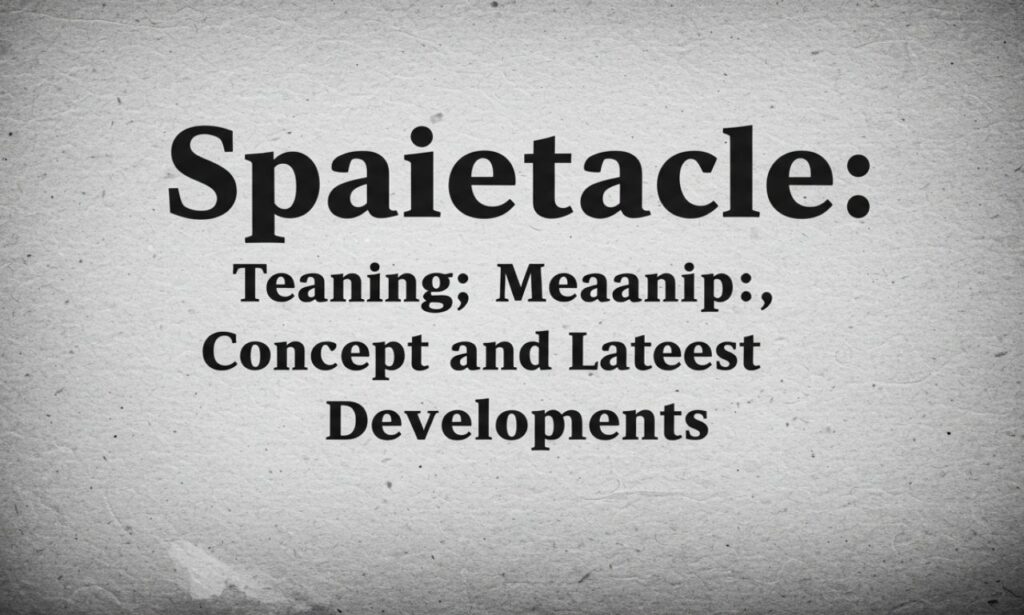Spaietacle has become one of the most intriguing and trending words in 2025, sparking interest in creative, cultural, and digital spaces. The term has been adopted by artists, technologists, and content creators to represent a unique blend of spectacle and spatial experience. It is more than just a catchy buzzword — it is a concept that reshapes how we think about performance, storytelling, and digital interaction. This article explores the meaning of spaietacle, its origins, cultural relevance, examples, and its future potential.
Spaietacle Meaning and Definition
At its core, spaietacle is a fusion of two ideas: “space” and “spectacle.” It represents an experience that is immersive, visually impactful, and contextually tied to the environment in which it happens. While a spectacle usually focuses on what is being seen, spaietacle emphasizes where and how it is being seen.
This concept is becoming increasingly popular in architecture, event design, gaming, and virtual reality, where spatial awareness plays a critical role in creating memorable experiences.
Spaietacle Origin and Early Use
The origin of the word spaietacle is difficult to trace precisely, but it began gaining traction in creative communities in the early 2020s. Influencers, architects, and stage designers began using the term to describe immersive events that go beyond simple performance or display. By 2024, the term had found its way into discussions about VR exhibitions, mixed reality installations, and interactive media experiences.
Spaietacle in Architecture and Design
Spaietacle has strong ties to architecture, where designers focus on creating spaces that feel alive and dramatic. The emphasis is not only on the aesthetic appeal but also on the emotions evoked as a person moves through the space.
-
Museum exhibits now integrate sound, light, and interactive elements to transform a simple room into a spaietacle.
-
Retail spaces use design to make shopping an experience, with curated lighting, textures, and music creating a theatrical feel.
-
Public art installations take over streets and parks, offering passersby a moment of awe.
In these contexts, spaietacle becomes a way to merge function and emotion.
Spaietacle in Technology and Digital Media
In the digital age, spaietacle has become central to VR, AR, and gaming development. The goal is to create virtual spaces that feel real and captivating, giving users a sense of presence and wonder.
Examples include:
-
Immersive VR concerts where users can walk around the venue virtually, choosing their perspective.
-
Interactive AR storytelling that places characters and scenes in real-world locations.
-
Video game environments that feel like living worlds rather than static backdrops.
Spaietacle makes digital engagement more meaningful by grounding the experience in a sense of space.
Spaietacle in Cultural Events and Performances
Live entertainment is one of the strongest domains where thrives. Theaters, music festivals, and dance shows use space creatively to surround audiences with sound, light, and movement.
-
360-degree stage designs allow audiences to view performances from multiple angles.
-
Projection mapping turns buildings into moving canvases during festivals.
-
Pop-up events transform everyday places into temporary spectacles.
Spaietacle turns spectators into participants by making them part of the environment.
Spaietacle in Marketing and Branding
Brands are also embracing to create memorable campaigns. Instead of traditional billboards and commercials, companies are building immersive experiences that invite consumers to explore.
Examples:
-
A sneaker brand launching a pop-up store designed like a futuristic city.
-
A car company unveiling a new model in a virtual showroom that customers can explore in 3D.
-
Tech companies hosting hybrid product launches where the physical and digital worlds blend seamlessly.This approach builds stronger emotional connections with audiences.
Psychological Impact of Spaietacle
Spaietacle works because it engages multiple senses at once. When people are surrounded by light, sound, and spatial design, they experience heightened emotions and better memory retention. Studies in environmental psychology show that well-designed spaces can reduce stress, improve creativity, and inspire awe.
Marketers and event organizers leverage this effect to create moments that stay in people’s minds long after the event is over.
Challenges in Creating Spaietacle
Despite its appeal, creating a true is not easy. Designers and planners face several challenges:
-
High costs of production, especially with advanced lighting, sound, and interactive technologies.
-
Accessibility issues, as not every space can be transformed into an immersive environment.
-
Technical limitations in VR and AR that still prevent complete realism.
Successful balance innovation, cost-effectiveness, and audience accessibility.
Future of Spaietacle in 2025 and Beyond
The future of spaietacle is tied to technology’s growth. With advancements in AI-driven design, holography, and spatial computing, the possibilities are expanding. Future may include:
-
AI-personalized environments where the space adapts to individual preferences.
-
Mixed-reality theaters that merge live performance with holographic storytelling.
-
Global virtual festivals where participants across continents share the same immersive experience.
As technology becomes more accessible, could become a regular part of education, entertainment, and workspaces.
Conclusion: Spaietacle as the Future of Experience
Spaietacle is more than a trend — it is a rethinking of how humans engage with space and spectacle. Whether in art, marketing, gaming, or events, the focus is on creating memorable, immersive, and emotionally charged experiences. As we move deeper into 2025, will likely influence not only entertainment but also education, healthcare, and workplace design. The rise of this concept shows that the future is not just about what we see, but how and where we experience it.







